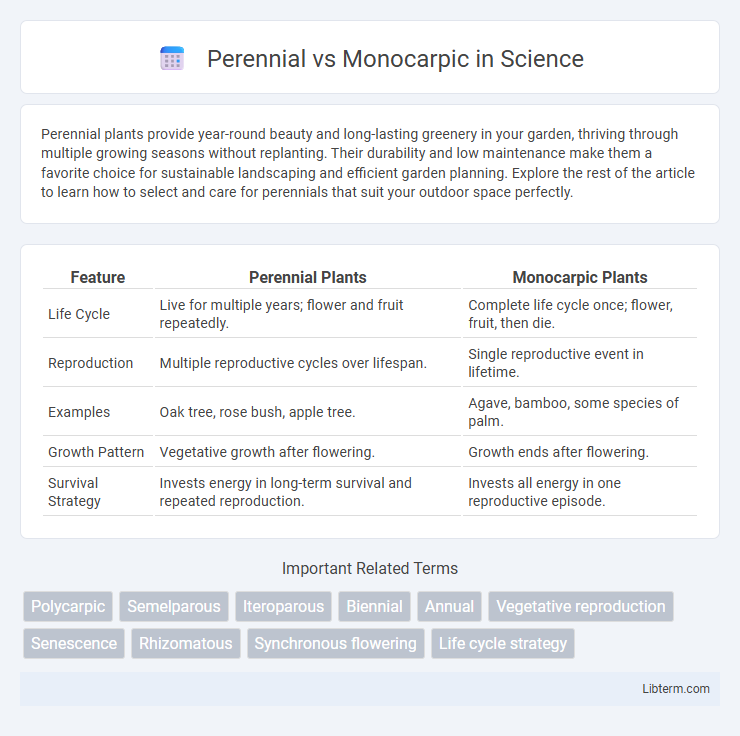Perennial plants provide year-round beauty and long-lasting greenery in your garden, thriving through multiple growing seasons without replanting. Their durability and low maintenance make them a favorite choice for sustainable landscaping and efficient garden planning. Explore the rest of the article to learn how to select and care for perennials that suit your outdoor space perfectly.
Table of Comparison
| Feature | Perennial Plants | Monocarpic Plants |
|---|---|---|
| Life Cycle | Live for multiple years; flower and fruit repeatedly. | Complete life cycle once; flower, fruit, then die. |
| Reproduction | Multiple reproductive cycles over lifespan. | Single reproductive event in lifetime. |
| Examples | Oak tree, rose bush, apple tree. | Agave, bamboo, some species of palm. |
| Growth Pattern | Vegetative growth after flowering. | Growth ends after flowering. |
| Survival Strategy | Invests energy in long-term survival and repeated reproduction. | Invests all energy in one reproductive episode. |
Understanding Perennial and Monocarpic Life Cycles
Perennial plants live for multiple years, producing flowers and seeds repeatedly throughout their lifespan, which allows for sustained growth and reproduction over time. Monocarpic plants undergo a single reproductive cycle, blooming once before they complete their life cycle and die, dedicating all energy to one reproductive event. Understanding these life cycles is crucial for horticulture and agriculture, as it influences planting strategies and crop management based on the longevity and reproductive patterns of the plants.
Key Differences Between Perennials and Monocarpic Plants
Perennials live for multiple growing seasons, producing flowers and seeds annually, while monocarpic plants flower once, set seed, and then die. Perennials allocate energy to root and shoot growth after each blooming cycle, supporting prolonged life span. Monocarpic species invest all reproductive resources into a single, often large, flowering event before senescence.
Advantages of Growing Perennial Species
Perennial species offer substantial advantages including reduced soil erosion due to their long-lasting root systems and decreased need for replanting, which saves labor and input costs. Their ability to thrive over multiple growing seasons enhances ecosystem stability, increases biodiversity, and supports sustainable agricultural practices. Perennials also improve carbon sequestration, contributing to climate change mitigation efforts.
Benefits and Uses of Monocarpic Plants
Monocarpic plants, which flower, set seed, and then die, offer advantages such as concentrated energy investment for a single, robust reproductive event, resulting in high seed output and genetic dispersal efficiency. These plants are valuable in agriculture and horticulture for producing large quantities of seeds or fruits in a short time, making them ideal for crops like agave, bamboo, and certain grains. Their life cycle supports sustainable harvesting cycles and helps in habitat restoration by quickly populating new or disturbed areas with pioneer species.
Examples of Common Perennial Plants
Examples of common perennial plants include lavender, hostas, and peonies, which live for multiple years and bloom repeatedly throughout their lifespan. Unlike monocarpic plants, such as agave and many bamboo species that flower once before dying, perennials continuously renew their growth each season. These plants are favored in gardens for their sustainability and ability to provide consistent greenery and blooms over time.
Notable Monocarpic Plant Varieties
Notable monocarpic plant varieties include agave, bamboo, and certain species of orchids like the genus Grammatophyllum, which flower once before dying. These plants invest significant energy into a single, massive reproductive event, producing abundant seeds or offsets for propagation. Understanding the biology of monocarpic plants aids in horticulture and agriculture, ensuring proper lifecycle management and optimal harvest timing.
Cultivation and Care Tips for Perennials
Perennials require consistent watering during their growing season, with emphasis on preventing waterlogging by ensuring well-drained soil to promote healthy root development. Mulching around perennial plants conserves moisture, regulates soil temperature, and suppresses weeds, reducing maintenance efforts. Regular pruning after flowering encourages vigorous growth and helps maintain plant shape, while fertilizing with balanced nutrients supports sustained blooming across multiple seasons.
Growing and Managing Monocarpic Plants
Monocarpic plants complete their life cycle by growing, flowering, setting seed, and then dying after one season or several years, requiring careful timing in cultivation to maximize growth before flowering. Effective management involves providing optimal conditions--such as adequate nutrients, water, and light--during the vegetative stage to support robust growth and seed production. Gardeners must plan for the plant's inevitable senescence by collecting seeds for future propagation and preparing replacement crops.
Ecological Impact of Perennial vs Monocarpic Plants
Perennial plants contribute significantly to soil stability and biodiversity by maintaining continuous root systems and providing year-round habitats, which enhance ecosystem resilience. Monocarpic plants, producing seeds only once before dying, can lead to episodic nutrient cycling and sparse vegetation cover, potentially increasing soil erosion and reducing habitat complexity. The contrasting life strategies of perennial and monocarpic plants shape ecosystem dynamics, influencing carbon sequestration, soil health, and species interactions.
Choosing the Right Plant Type for Your Garden
Perennials offer the advantage of long-term growth, providing continuous blooms and foliage year after year, making them ideal for low-maintenance gardens with consistent visual appeal. Monocarpic plants, which flower once and then die, are best suited for gardeners seeking dramatic, singular flowering events and are willing to replant regularly for successive blooms. Selecting between perennial and monocarpic plants depends on desired garden longevity, maintenance commitment, and flowering patterns to achieve a balanced and vibrant landscape.
Perennial Infographic

 libterm.com
libterm.com